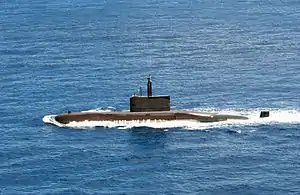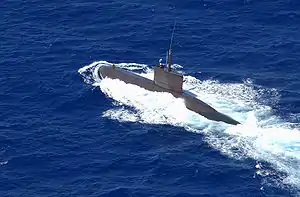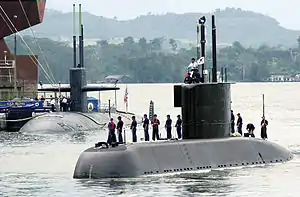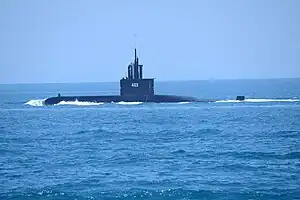Jang Bogo-class submarine
The Jang Bogo-class submarine (Hangul: 장보고급 잠수함, Hanja: 張保皐級潛水艦) or KSS-I (Korean Submarine-I) is a variant of the Type 209 diesel-electric attack submarine initially developed by Howaldtswerke-Deutsche Werft (HDW) of Germany, intended for service with the South Korean Navy and Indonesian Navy. A Daewoo (DSME)-upgraded model of the Jang Bogo class Type 209 was exported by Korea to Indonesia in 2012, amid heavy competition from Russian, French, and German-Turkish consortiums including from Germany's original Type 209.[3] The variant was considered for possible purchase by Thailand as well, as both newly built and second-hand options.[5] The class is named for ancient Korean maritime figure Jang Bogo.
 Republic of Korea (ROK) Jang Bogo Type 209/1200 Submarine Jang Bogo heads out to sea during exercise Rim of the Pacific (RIMPAC) 2004. | |
| Class overview | |
|---|---|
| Name | Jang Bogo class |
| Builders | |
| Operators | |
| Succeeded by | Type 214 submarine |
| Subclasses | Nagapasa class |
| Cost | |
| In commission | 1993–present |
| Planned | 15 |
| Completed | 12 |
| Active | 11 |
| Laid up | 1 |
| General characteristics | |
| Displacement | 1200–1400 tons |
| Length |
|
| Beam | 6.3 m (21 ft) |
| Draft | 5.5 m (18 ft) |
| Propulsion |
|
| Speed |
|
| Range |
|
| Endurance | 50 days |
| Test depth | 500 m (1,600 ft) |
| Complement | 33 |
| Armament |
|
Armaments
The Jang Bogo-class submarines are armed with eight bow 533 mm (21 in) torpedo tubes and fourteen torpedoes. The ships are also armed with Sub-Harpoon missiles and can be armed with 28 mines in place of torpedoes and Harpoon missiles.[6] The class is armed with SUT - Surface and Underwater Target Torpedoes.
Upgrades
The South Korean Jang Bogo-class submarines, originally based on Type 209/1200, had reportedly been heavily upgraded from a time early in the 21st century,[7] which if properly undertaken was supposed to include domestic hull stretch augmentation from 1,200 tons to 1,400 tons, and installment of domestically developed Torpedo Acoustic Counter Measures (TACM).[8][9] These upgrades could have been affected due to Korean economic problems of the late 1990s, which affected other plans to acquire nine 1,500-ton AIP-equipped boats or upgrade six 1200 boats to 1,500-tons AIP-equipped boats,[8][10][11] although the more ambitious plan to acquire nine 1,800-ton Type 214 AIP submarines was preserved and put under progress, which will reportedly be wrapped up in 2018 when all submarines of the type are scheduled to be commissioned. Outfitting the submarines with Sub-Harpoon launching capability was a part of the upgrade,[8] and this seems to have been properly carried out by 2002 on at least one submarine. By 2007, Na Daeyong and Lee Eokgi were demonstrated to have the capability.[12] In the 2008 RIMPAC the submarine Lee Sunshin also demonstrated its sub-harpoon capability.[13] By 2009 it was reported that nine South Korean-modified 1,400-ton Type 209 submarines were in service with the ROKN.[14][15] As of 2011 they were reported to be 1,200-ton Type 209 submarines.[16][17] They can equip the White Shark heavy torpedo,[9][18][19] and can possibly equip submarine-launched Hae Sung anti-ship missiles later on.[20][21] LIG Nex1 began producing TACM for unspecified submarine types of the ROKN as well, which finished development in 2000.[9][22] AIP and flank-array sonars are planned for future modernizations.[17] The Jang Bogo class offered to Indonesia will already be in stretched and augmented forms including guided missile-launching capabilities and a surface displacement of 1400 tons, quite similar to the original plan to upgrade the existing Jang Bogo-class submarines of ROKN to similar specifications.[3]
A science documentary by EBS reported that Jang Bogo-class submarines will undergo major generational overhaul and refit every eight to twelve years. The overhaul and refit involves periodic cutting, complete disassembly, and re-welding of the hull for the upgrade or total replacement of the submarine's old engines, navigational equipment, batteries, and other essential equipment with their modern counterparts. Hull stretch may also have taken place in some of the Jang Bogo-class vessels since the early 2000s, but it has neither been completely confirmed nor denied. Some Jang Bogo-class vessels are demonstrated to have sub-Harpoon launching capability when previously the class was lacking it. ROKN is committed to build and maintain a submarine force of 26 attack submarines until 2025, excluding small and midget submarines, though it is not clear how many submarines among those will belong to the Jang Bogo class.[23] The oldest commissioned Jang Bogo-class submarine by then will be 32 years old.
Lithium-ion battery power stacks are being developed to increase the underwater endurance of Jang Bogo-class submarines by two to three times, offering four to five times the power density of Type 209's current lead-acid batteries and as much as twice the power density of Type 214's BZM 120 fuel cells.[24][25]
Sales
In December 2011, DSME won a contract to build six 1,400-ton Chang Bogo-class submarines for Indonesia at a cost of $1.07 billion.[26] Construction of the submarines will start in January 2012 for delivery by 2015 and 2016, for commissioning in the first half of 2018. They'll be equipped with torpedoes and guided missiles.[27][28] The submarines are described to be Korea's original model, bigger and more advanced than Indonesia's refurbished Type 209/1300.[3] Initially the offered submarines were going to be in-service ROKN submarines.[29] The sale will be done without the involvement of German companies.[30] South Korea is currently the only country outside Germany independently offering the Type 209 for sale. Indonesia was also offered two license built Type 209 submarines manufactured by a group of Turkish (SSM - Undersecretariat for Defense Industries) and German companies (HDW/ThyssenKrupp), a deal reported to be valued at $1 billion.[31] SSM was also offering the leases of Type 209 submarines until new submarines could be completed.[30] The offer has since been superseded by the DSME submarine contract. In early 2012, the Korean defense firm LIG Nex1 exhibited its latest suite of indigenously developed submarine sensors, submarine combat systems, and heavy-weight torpedoes and wire-guided torpedoes in Indonesia for potential use by the Indonesian Navy's submarine forces.[32]
Improved Jang Bogo class
In 2011, DSME signed a contract with Indonesia on for the supply of three Improved Jang Bogo-class submarines. These submarines will be equipped with Atlas Elektronik CSU 90 hull-mounted passive and active search-and-attack sonar and flank sonar arrays, Indra's Pegaso RESM system and Aries low-probability of intercept radar,[33] L3's MAPPS integrated platform management systems[34] and Safran's Sigma 40XP inertial navigation systems.[35]
The improved submarines are also known as Nagapasa-class submarines.[36]
In 2019, South Korea signed another contract worth US$1.02 billion to sell three 1,400-ton submarines to Indonesia[4] and would be supported through a loan agreement.[37]
Incidents
On July 15, 2020 05:00 UTC, the Norwegian merchant ship Hoegh London (IMO 9342205) collided with an unknown South Korean Jang Bogo-class submarine near Gadeokdo Island, Busan, South Korea.[38][39]
Boats in class
| Country | Type | Pennant | Name | Commissioned |
|---|---|---|---|---|
| Jang Bogo class | SS-061 | Jang Bogo | 1993 | |
| SS-062 | Lee Chun | 1994 | ||
| SS-063 | Choe Museon | 1995 | ||
| SS-065 | Park Wi | 1996 | ||
| SS-066 | Lee Jongmoo | 1997 | ||
| SS-067 | Jung Woon | 1998 | ||
| SS-068 | Yi Sun-sin | 2000 | ||
| SS-069 | Na Dae-yong | 2000 | ||
| SS-071 | Yi Eokgi | 2001 | ||
| Nagapasa class | 403 | Nagapasa | 2017 | |
| 404 | Ardadedali | 2018 | ||
| 405 | Alugoro | 2019 | ||
| 406 | To Be Determined | signed contract in 2019 - Determined | ||
| 407 | To Be Determined | signed contract in 2019 - Determined | ||
| 408 | To Be Determined | signed contract in 2019 - Determined | ||
Pictures
- Jang Bogo-class Gallery
 Republic of Korea (ROK) Chang Bogo Type 209/1200 submarine Nadaeyong (SS 069) surfacing during a SINKEX for Rim of the Pacific RIMPAC 2002.
Republic of Korea (ROK) Chang Bogo Type 209/1200 submarine Nadaeyong (SS 069) surfacing during a SINKEX for Rim of the Pacific RIMPAC 2002._leads_a_formation_of_U.S._and_coalition_forces_during_Rim_of_the_Pacific_(RIMPAC)_2010_exercises.jpg.webp) The Republic of Korea submarine ROKS Lee Eokgi (SS 071) leads a formation of U.S. and coalition forces during Rim of the Pacific (RIMPAC) 2010 exercises.
The Republic of Korea submarine ROKS Lee Eokgi (SS 071) leads a formation of U.S. and coalition forces during Rim of the Pacific (RIMPAC) 2010 exercises._arrives_at_Naval_Station_Pearl_Harbor.jpg.webp) The Korean submarine Lee Sunsin (SSK 068) arrives at Naval Station Pearl Harbor, becoming the first foreign vessel to arrive to take part in the Rim of the Pacific (RIMPAC) Exercise.
The Korean submarine Lee Sunsin (SSK 068) arrives at Naval Station Pearl Harbor, becoming the first foreign vessel to arrive to take part in the Rim of the Pacific (RIMPAC) Exercise. Sailors on board the Korean submarine Lee Chun stand at the ready, as they prepare to go pier-side in Apra Harbor, Guam. The Koreans are joining by other allied forces in Guam to participate in Exercise TANDEM THRUST '99.
Sailors on board the Korean submarine Lee Chun stand at the ready, as they prepare to go pier-side in Apra Harbor, Guam. The Koreans are joining by other allied forces in Guam to participate in Exercise TANDEM THRUST '99. The Korean submarine Choi Museon makes its way past the United States Navy's USS Helena (Los Angeles class) and into the Sembawang port facilities in Singapore during Exercise PACIFIC REACH 2000.
The Korean submarine Choi Museon makes its way past the United States Navy's USS Helena (Los Angeles class) and into the Sembawang port facilities in Singapore during Exercise PACIFIC REACH 2000._2010_pierside_at_Joint_Base_Pearl_Harbor-Hickam%252C_Hawaii.jpg.webp) The Republic of Korea submarine Lee Eokgi (SS-071) prepares for Rim of the Pacific (RIMPAC) 2010 pierside at Joint Base Pearl Harbor-Hickam, Hawaii.
The Republic of Korea submarine Lee Eokgi (SS-071) prepares for Rim of the Pacific (RIMPAC) 2010 pierside at Joint Base Pearl Harbor-Hickam, Hawaii. Indonesian Navy submarine KRI Nagapasa (403) during the annual armed force anniversary in Merak, Banten, 2017.
Indonesian Navy submarine KRI Nagapasa (403) during the annual armed force anniversary in Merak, Banten, 2017.
See also
References
- Franz-Stefan Gady (2016-03-29). "South Korea Launches First Indonesian Stealth Submarine". The Diplomat. Archived from the original on 2017-05-02.
- "Korea wins $1 bil. Indonesian deal". koreatimes. 2011-12-20. Archived from the original on 2023-09-11. Retrieved 2023-09-11.
- "S. Korea signs contract to export 3 submarines to Indonesia | Yonhap News Agency". Yonhap News Agency. 12 April 2019. Retrieved 12 April 2019.
- "Thailand Nixes Second-Hand U206 Submarine Deal But Stands up a Sub Squadron". Defense Industry Daily. 10 July 2014. Archived from the original on 29 July 2012. Retrieved 11 September 2023.
- Watts, Anthony (2006). Jane's Warship Recognition Guide. Harpercollins. p. 384. ISBN 978-0-00-718327-2.
- ARG. "Chang Bogo Class Patrol Submarine - Military-Today.com". www.military-today.com.
- "Defense & Security Intelligence & Analysis: IHS Jane's - IHS". articles.janes.com.
- "www.tradeKorea.com". www.tradekorea.com. Archived from the original on 2014-12-19. Retrieved 2018-03-24.
- Kim, Duk-Ki (2000). Naval Strategy in Northeast Asia: Geo-strategic Goals, Policies and Prospects. Routledge. p. 30. ISBN 978-0-7146-4966-5.
- Meconis, Charles; Wallace (2000). East Asian Naval Weapons Acquisitions in the 1990s: Causes, Consequences, and Responses. Praeger. p. 229. ISBN 978-0-275-96251-7.
- "Honolulu Star-Bulletin Hawaii News". archives.starbulletin.com.
- RIMPAC Exercise and Republic of Korea Navy
- "Seapower - February 2008 - 52". www.seapower-digital.com. Archived from the original on December 27, 2008.
{{cite web}}: CS1 maint: unfit URL (link) - Indonesian Redtape Torpedoes Sub Sale Bid Archived September 29, 2013, at the Wayback Machine
- Sagem to modernize navigation system on South Korea's KSS-1 submarines Archived May 10, 2012, at the Wayback Machine
- "알림메세지". navy.mil.kr.
- "White Shark". www.deagel.com.
- "South Korea's weapons story Domestic torpedo Great White".
- Pike, John. "ASM/SSM-700K Sea Star (Haesung / Haeseong / Haesong)".
- "Defense & Security Intelligence & Analysis: IHS Jane's - IHS". articles.janes.com. Archived from the original on 2012-05-09. Retrieved 2012-03-02.
- LIG Nex1 TACM Archived October 12, 2015, at the Wayback Machine
- "Attack Submarine Deployments in the Pacific". Archived from the original on 2011-04-03.
- "Effectiveness of Lithium-Ion Battery Technology to ROK Submarine Force".
- "Comparison of Lead-Acid Battery and Lithium-Ion Batteries for Type 209".
- Post, The Jakarta. "RI orders 3 submarines worth $1b in regional 'catch-up'".
- "South Korea Exports Submarines to Indonesia". Archived from the original on 2013-01-21.
- "Sagem navigation system selected by DSME of South Korea for Indonesian submarines". November 25, 2013.
- "Defense & Security Intelligence & Analysis: IHS Jane's - IHS". articles.janes.com. Archived from the original on 2012-05-09. Retrieved 2012-03-02.
- "Hürriyet Daily News". Hürriyet Daily News.
- "Hürriyet Daily News". Hürriyet Daily News.
- Batik Photography (18 January 2012). "Presentasi LIG Nex1.mp4" – via YouTube.
- "Indra to implement its technology in Indonesia's type 209 submarines for more than €10M | Indra". Archived from the original on 2014-12-19. Retrieved 2014-12-19.
- "Archived copy" (PDF). Archived from the original (PDF) on 2014-01-02. Retrieved 2014-01-01.
{{cite web}}: CS1 maint: archived copy as title (link) - "Sagem navigation system selected by DSME of South Korea for Indonesian submarines". 25 November 2013.
- Rahmat, Ridzan (26 February 2019). "Launch of Indonesia's third Nagapasa-class submarine delayed by silting | Jane's 360". Janes360. Retrieved 12 April 2019.
- "DSME to deliver three more submarines to Indonesia | Jane's 360". Janes360. 12 April 2019. Retrieved 12 April 2019.
- Norwegian car carrier collided with Korean submarine Maritime Bulletin. Mikhail Voytenko. July 17, 2020. Retrieved August 23, 2020.
- 해군 잠수함-노르웨이 상선 충돌사고…'교신 오류'가 원인 (in Korean) Newsis. August 20, 2020. Retrieved August 23, 2020.